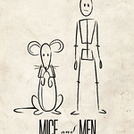Students will be reading and writing myths. They will follow the structure of short stories and eventually publish their work.
- Subject:
- Secondary English Language Arts
- Material Type:
- Lesson
- Author:
- Utah Lesson Plans
- Date Added:
- 10/20/2021
Students will be reading and writing myths. They will follow the structure of short stories and eventually publish their work.
The 7th grade poetry unit gives an in depth approach to poetry involving the four strands within the core. I've included worksheets, rubrics, and answers keys where applicable. I have also used literature examples from the core.
Students will be creating a variety of poetry as well as analyzing poetry. They will work with Language standards and take a performance assessment at the end of the unit.
In this lesson, students analyze the allusions, slang, and literary analogies used in "Raymond's Run" by Toni Cade Bambara. To extend understanding, they will then write their own allusions and analogies.

This lesson plan was made as a summative assessment after reading the American novel, Of Mice and Men. It is essential that students have read the novel and have access to either an iPhone, iPad, or Mac Computer for completion of this project via the Pages App. Students are often disappointed and frustrated with the ending of John Steinbeck’s Of Mice and Men, feeling that there are many other solutions to the problems of the characters. They are not alone; thousands of readers have also pled the same case. Well now, they have their chance to rewrite the ending and give George and Lennie the resolutions they think they deserve. For this assignment, they are to rewrite the final chapter using the Pages App via iPhone or iPad. "… of Mice And Men …" by bjornmeansbear is licensed under CC BY-SA 2.0. To view a copy of this license, visit https://creativecommons.org/licenses/by-sa/2.0/?ref=openverse.
This lesson extends over several class periods. Students analyze the claim, grounds, warrants, qualifiers and counterclaims in three articles about the American Dream. Students conduct research and find two additional articles about the American Dream. Students then analyze the argument in those articles. Finally, students write their own argument essay about the current state of the American Dream.
Students use the Informational Text Analysis Tool to deconstruct the essential elements of informational text.
Students individually consider a visual text and draw conclusions based on what they see. They write about their conclusions and explain the evidence used to make that determination.
This 14 day Unit Plan integrates the Utah Core Standards for Language Arts and for Reading and Writing in History/Social Studies with the existing Utah Social Studies Standards. The students read, research, draw conclusions, and write beginning level argumentative essays comparing/contrasting major world religions. For a more thorough summary see the Background For Teachers section.
In this 28 day unit, students will gain background information on historic wars, compare different genres' presentations of events, recognize different points of view, research an essential question, compile evidence, create warrants that lead to a claim which answers the essential question, and write an argumentative essay.
Students will discover a policy within their school or district that is important to them and that they'd like to change. They will conduct an investigation of the policy in question and write a letter with their claim, results, and recommendation to the appropriate audience.

This lesson plan meets the secondary requirements for The Engish Language Arts Standard Reading: Literature Grades 7-12 with the option of meeting the additional standard of Speaking and Listening. This lesson offers specific details with flexibility for implementation in the classroom. Students can work independently or in groups and be able to create their final book project using technology.

This lesson plan meets the secondary requirements for The Engish Language Arts Standard Speaking and Listening Standards 4 & 5. This lesson offers specific details with flexibility for implementation in the classroom. Students can choose how they would like to present their information using their choice of multimedia tool.

This lesson plan meets the secondary requirements for The Engish Language Arts Standard Reading: Literature Grades 7-12 with the option of meeting the additional standard of Speaking and Listening. This lesson offers specific details with flexibility for implementation in the classroom. Students can work independently or in groups and be able to create their final book project using technology.

Students will capture their own images to promote or recommend a book from their personal reading. This assignment is designed to blend principles from digital photography, design, and library media standards to demonstrate deeper understanding and critical thinking skills. This lesson plan was created by Andrea Settle then remixed by Melissa Jensen.Image: "Student Photographer" by Melissa Jensen is licensed under CC BY-NC-SA 2.0
In this set of lessons which extend over several days, students read excerpts from "The Death of Benny Paret" by Norman Mailer and "The Fight" by William Hazlitt. Students annotate the text, specifically looking for metaphor and simile, tone, and syntax. Working with a partner, students write three paragraphs, analyzing metaphor or simile, tone, and syntax in "The Death of Benny Paret." Working independently, students write one paragraph, choosing to analyze metaphor or simile, tone, or syntax in "The Fight."

This is a lesson plan regarding middle school research. Students first complete their career research (different lesson plan). Next they complete this lesson which is completing a biography on an important person in their chosen career. Picture taken by Jann Leishman

Students examine propaganda and media bias, research a variety of banned and challenged books, choose a side of the censorship issue, and support their position through an advertising campaign.
This set of lessons extends over several weeks and incorporates all acts of Arthur Miller's play, The Crucible. Students will closely read The Crucible. Students will cite textual evidence and make interpretations about character development.Students will combine the textual evidence with their interpretations and write interpretive statements. In the culminating activity, students will write a character analysis.

This is a lesson plan is meant to assist in teaching and assessing students' ability to identify character development, types, and changes. This resource can be modified to fit a novel unit study, short stories, or plays. The resource is intended to be used as a digital element in an in-person class but can be modified to fit other class types and modalities.Cover image: Photo by NeONBRAND on Unsplash